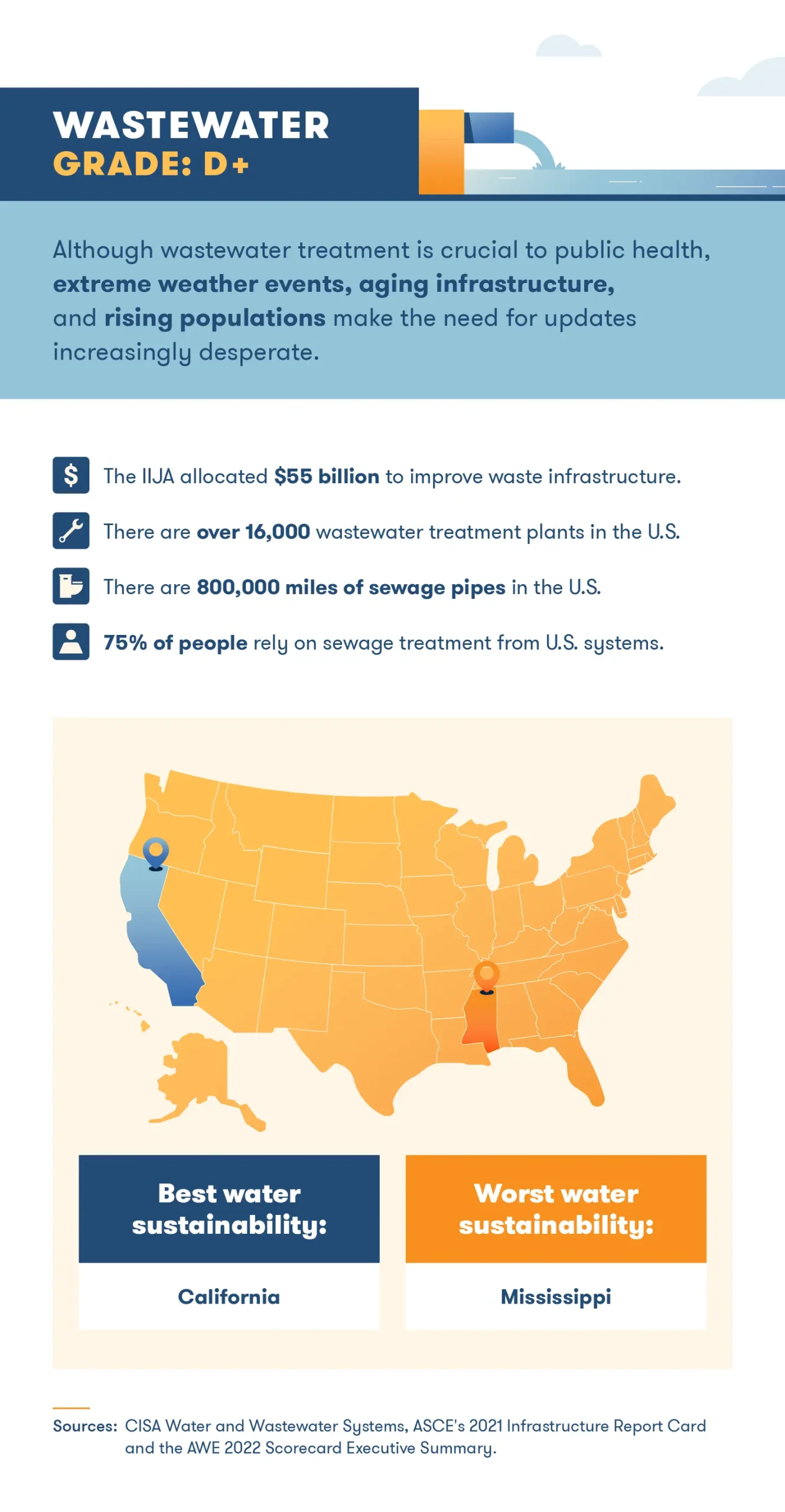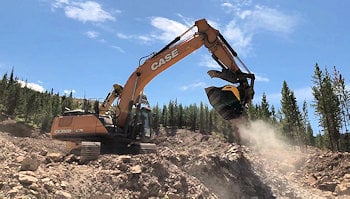United States Infrastructure: Past, Present and Future
In November 2021, Congress passed the bipartisan Infrastructure Investment and Jobs Act (IIJA). The IIJA funds desperately needed improvements to the United States infrastructure. This historic bill is the largest commitment to U.S. infrastructure in over 100 years.
The IIJA includes $500 billion allocated for surface transportation systems, $73 billion to update the electric grid, $55 billion to improve countrywide water quality and $50 billion to support community resilience in the face of climate change, cyberattacks and more.
After generations of neglect, American infrastructure statistics indicate a need for significant maintenance and repairs. Since its launch in 2021, the IIJA has funded over 40,000 projects across 4,500 communities around the country.
Knowing the current state of U.S. infrastructure allows us to understand things like tax budgets, government spending, state and federal improvement projects and — most importantly for the construction industry — government building contracts.
Read on for the basics about United States infrastructure, focusing on seven main sectors: bridges, roads, the rail network, aviation, drinking water, wastewater and energy.
Table of Contents:
- Rail Network
- Bridges
- Energy
- Wastewater
- Drinking Water Systems
- Aviation
- Roads
- FAQ
Rail Network
Private companies own most of the country’s rail infrastructure, with most of the nation’s major passenger routes operated almost exclusively by Amtrak. Private freight rail companies invest an annual average of $23 billion in privately owned networks. This is six times more than the national average and supports modernization, increases safety, improves service and reduces emissions.
Nevertheless, rail infrastructure has an uphill battle in terms of challenges ahead, especially when it comes to passenger railways. Nationwide, locomotive infrastructure is aging quickly, and restoration projects remain underfunded.
In 2023, Amtrak served 28 million Americans — bouncing back from lower pre-pandemic levels. With the help of the United States infrastructure bill, they plan to increase ridership up to 66 million annual travelers by 2040. To reach this goal, Amtrak committed approximately $5.5 billion for several backlogged projects like updating bridges and tunnels, modernizing trains and hiring over 3,500 employees to meet growing demand. 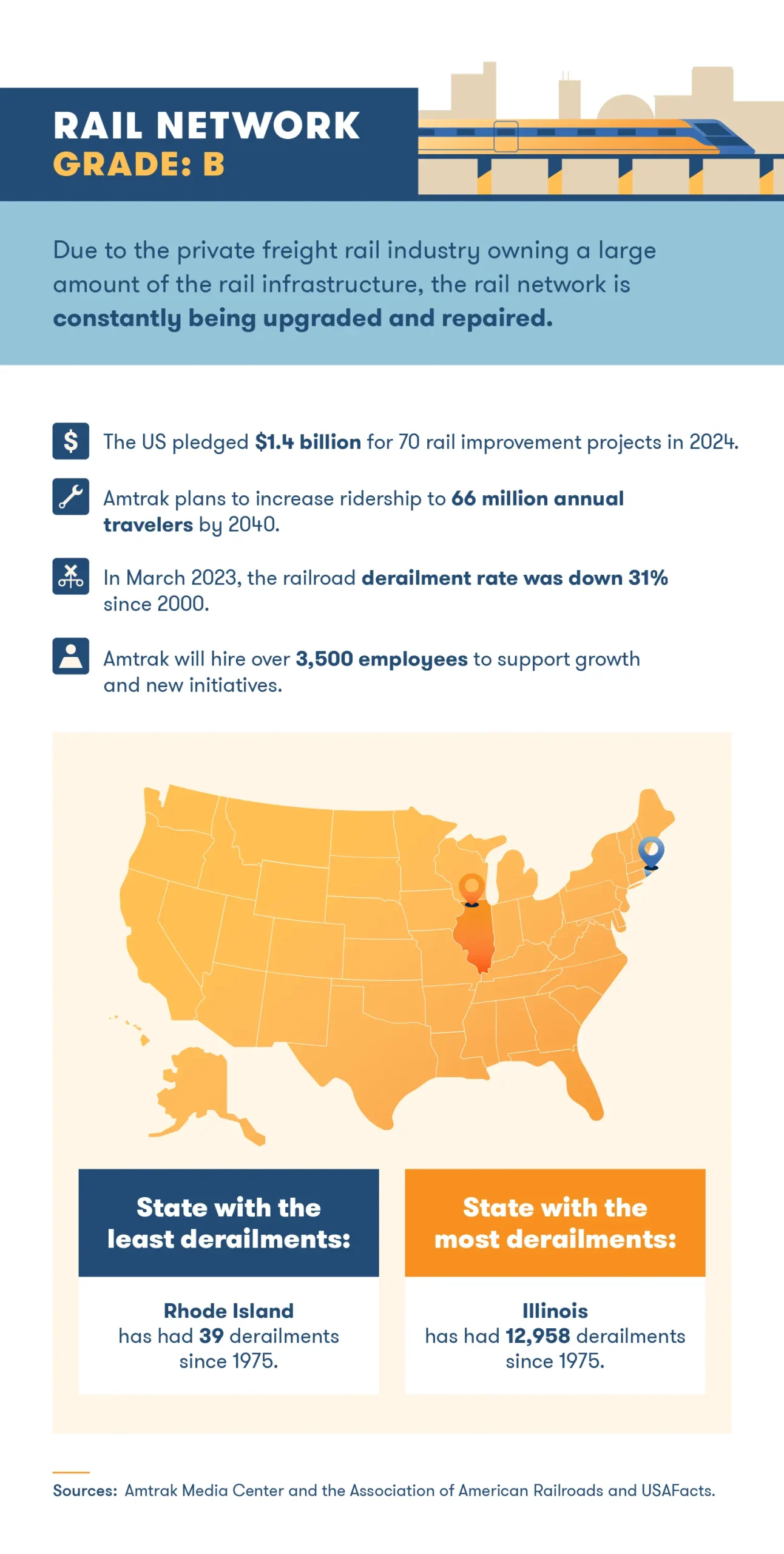
Bridges
According to the American Road and Transportation Builders Association (ARTBA), 1 in 3 US bridges require replacement or repair. Of these bridges, 42,400 are deemed “structurally deficient,” yet people cross them approximately 167 million times a day.
They may not collapse in the middle of rush hour, but they need plenty of attention before existing issues deteriorate to a point where the structures are unsafe.
The estimated backlog for bridge repairs is $125 billion, and annual spending needs to increase from $14.4 billion to $22.7 billion to make necessary improvements. A systematic preservation program prioritizing preventive maintenance is crucial to address this issue.
Fortunately, the new United States infrastructure bill recently allocated funds to the Bridge Investment Program. This program is the largest bridge investment in U.S. history and supports the replacement, rehabilitation and preservation of poor or at-risk bridges with $40 billion allocated over five years. 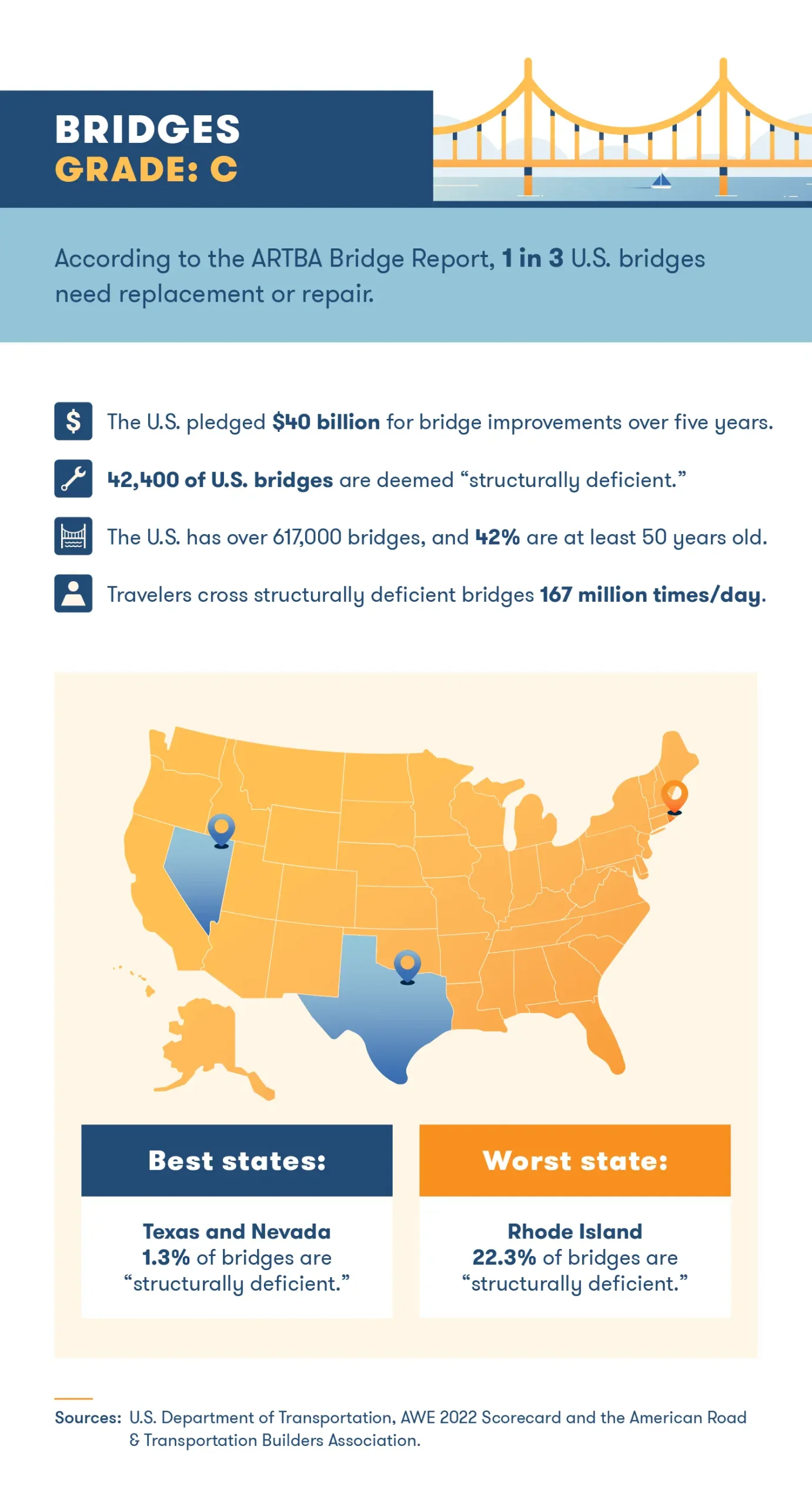
Energy
The U.S. energy infrastructure sector is in dire need of an overhaul. Most of our electrical transmission and distribution lines were built during the 1950s or 1960s. It’s safe to say these older lines are in need of an upgrade.
The current energy infrastructure is a combination of modern and outdated technology that can be unreliable. Upgrading grid infrastructure will help meet modern energy needs and protect it from future issues.
It’s generally agreed that Alaska, West Virginia and Hawaii have the lowest levels of power grid reliability in the U.S. Conversely, South Dakota, Oregon and Washington hold the most reliable power grids.
Regardless of each state’s ranking, more renewable energy resources are necessary to address climate change and the aging United States infrastructure. Renewable energy sources are the fastest-growing sources of electricity in the U.S. — but they only make up about 21% of total energy use in the country.
Fortunately, the new U.S. infrastructure bill addresses this problem with over $97 billion in funding for energy efficiency and clean energy projects. This has the power to
as climate change continues to impact construction jobs and careers in other industries. 
Wastewater
There are over 16,000 wastewater treatment plants in the country, and they play a vital role in the overall health of U.S. infrastructure.
Out of all 50 states, California ranks the highest when it comes to water efficiency and sustainability. Their state-level policies encourage water conservation, lower water bills, reduce greenhouse gas emissions and protect natural waterways. Mississippi occupies the opposite end of the spectrum and holds the lowest ranking. This is due to many factors, including a lack of water efficiency and conservation investments.
Keeping this section of infrastructure running and up to date is crucial for public and environmental health. Aging treatment plants and pipelines are a costly challenge for the U.S. In 2019, utilities spent over $3 billion, or more than $18 per customer, to replace pipelines across the country.
More water treatment and sewage lines are needed to support the U.S. population growth and rapid urban development. The 2021 United States infrastructure bill addresses this need with a historic investment in the nation’s water infrastructure. It includes supplying the U.S. Environmental Protection Agency (EPA) with $55 billion to improve wastewater infrastructure.
This new investment is six times larger than previous amounts and indicates a bright future for U.S. infrastructure.
Drinking Water Systems
Drinking water infrastructure has always been one of the most important construction aspects of a new city, but it’s in dire need of upgrades and replacement.
Many dangers threaten American drinking water. This includes an aging U.S. infrastructure (with some pipes that are over 100 years old) and harmful contaminants like lead and toxic algae in the water supply.
Hawaii takes its drinking water seriously and has some of the best public tap water in the country. Conversely, Pennsylvania reported 21,527 water quality violations in 2023, making it the worst offender out of all 50 states.
Regardless of this, Flint, Michigan, has perhaps the most well-known case of contaminated water. Their story surfaced in 2014 when lead entered the city’s water supply after the government failed to treat the source properly. This contamination led to many health conditions among residents, including skin rashes and hair loss.
However, Flint isn’t the only city with active lead pipes — 2,800 active lead pipes crisscross every state in the country. This impacts roughly 22 million people, mostly from low-income households or minority groups.
The IIJA will address these dangerous contaminants plaguing the U.S. Infrastructure with over $50 billion dedicated to a safe drinking water package. 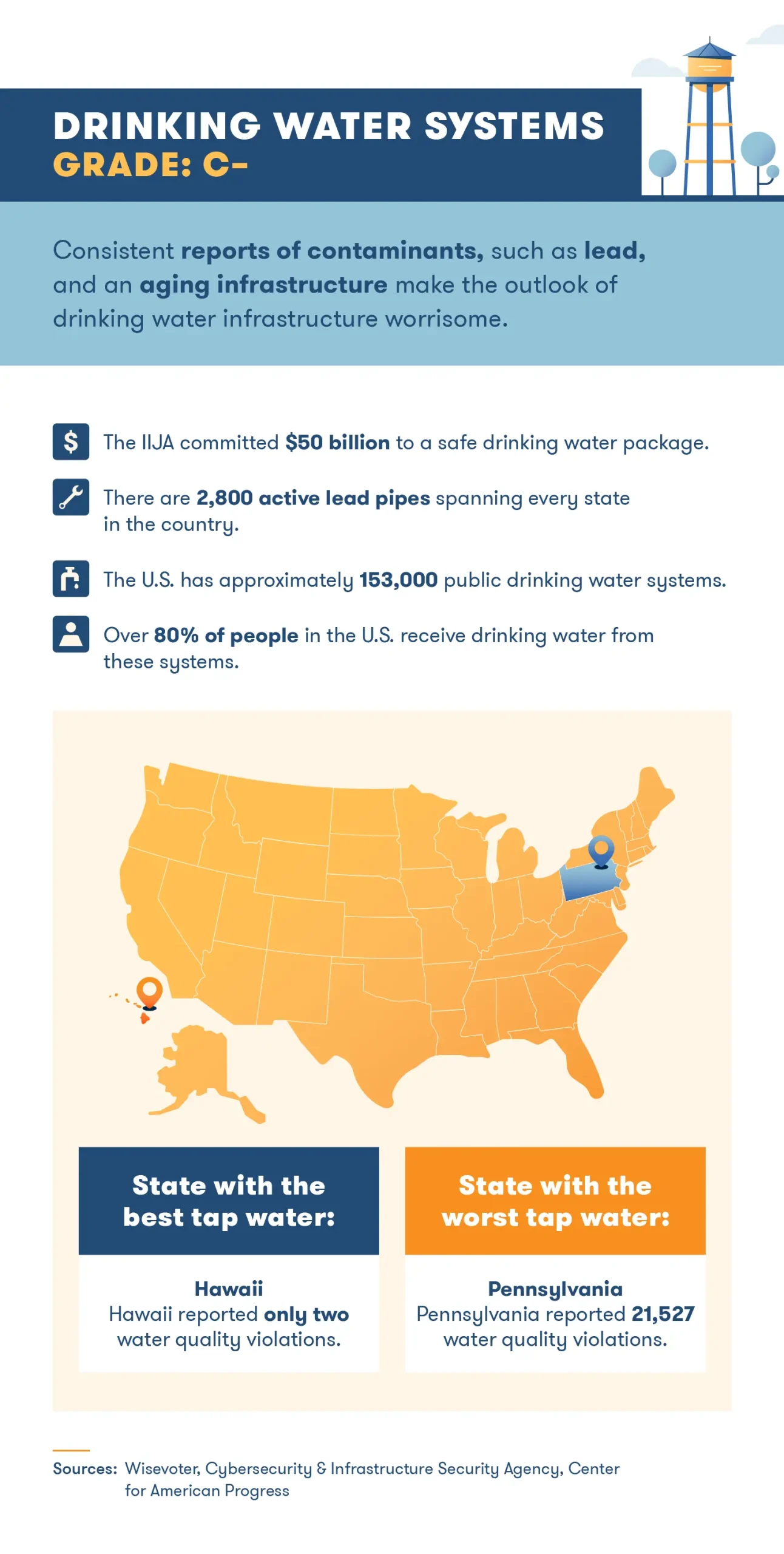
Aviation
With over 2.9 million passengers per day, U.S. airlines are some of the most used methods of travel and transportation in the country. In fact, the United States’ air travel industry moves more people than any other country’s system.
The aviation infrastructure (which consists of security, capacity, etc.) has not kept up with the massive demand, resulting in overcrowded airports all across the U.S. These challenges are made worse by a pilot shortage, record-breaking traveler volumes and weather complications.
Despite these difficulties, the J.D. Power 2023 North America Airport Satisfaction Study showed a 3-point increase in overall traveler satisfaction. This positive trend is credited to better terminal facilities, food and beverage services and a better baggage claim experience.
The IIJA will also play a role in future improvements, with $25 billion allocated for the Federal Aviation Administration (FAA) to update the outdated aviation infrastructure. 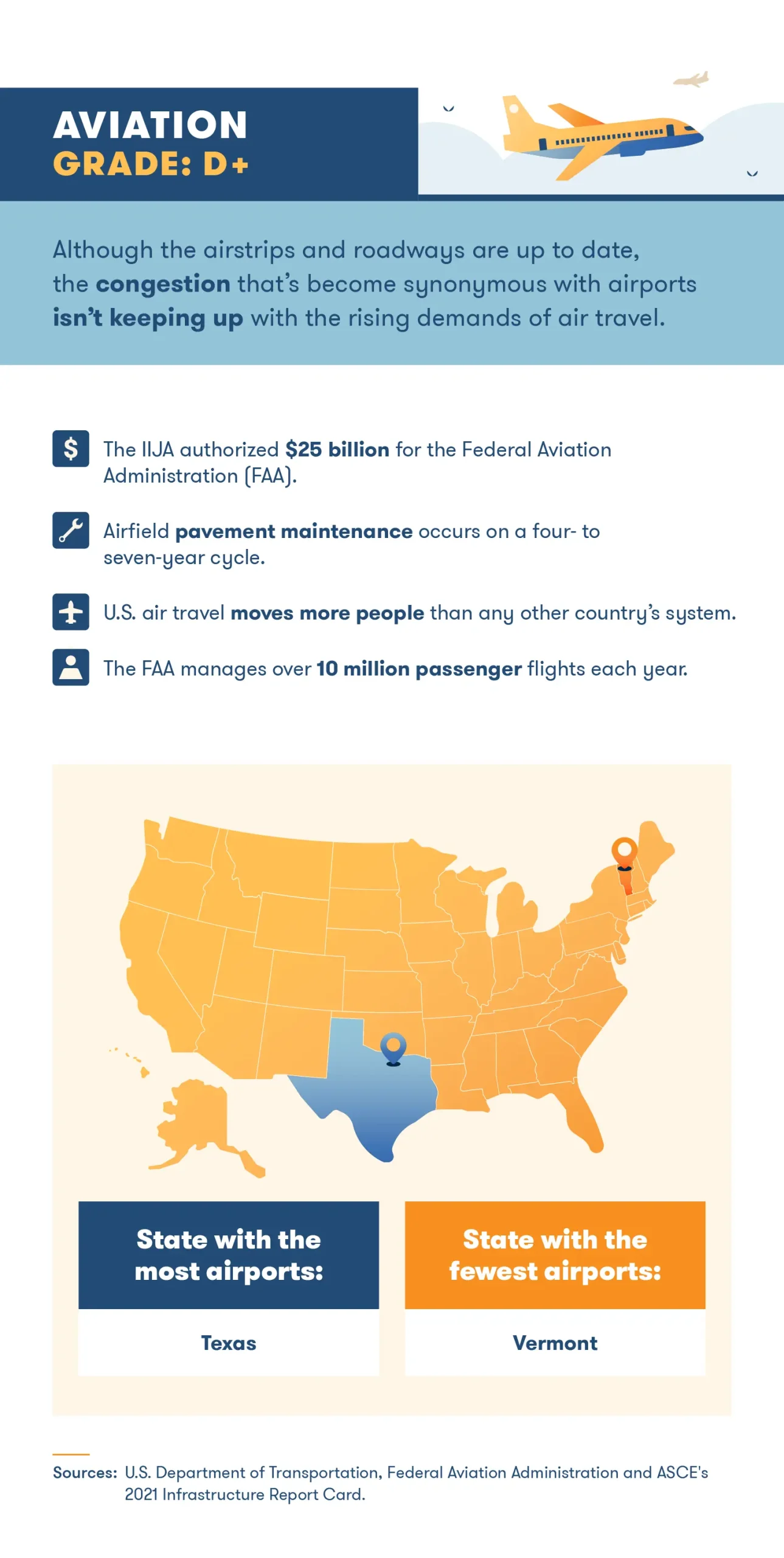
Roads
Public roads are one of the most visible and important forms of infrastructure. The United States has over 4.19 million miles of road across the country, but much of it requires significant repairs.
In 2021, 43% of U.S. road systems were labeled as suffering from mediocre or poor conditions. American roads play a crucial role in daily life and our economy but have historically lacked sufficient funding.
Motorists pay an estimated $1,000 annually on wasted fuel and time due to these poor road conditions and around 36,000 people die on U.S. roads every year. This led to the IIJA increasing funds for the roads that make up U.S. infrastructure.
With the support of the IIJA, states across the country will support over 2,300 new projects with approximately $2.6 billion in funding from the new bill. This surge in funding has the potential to create 13,000 new jobs for every $1 billion invested in the U.S. bridge and highway infrastructure. 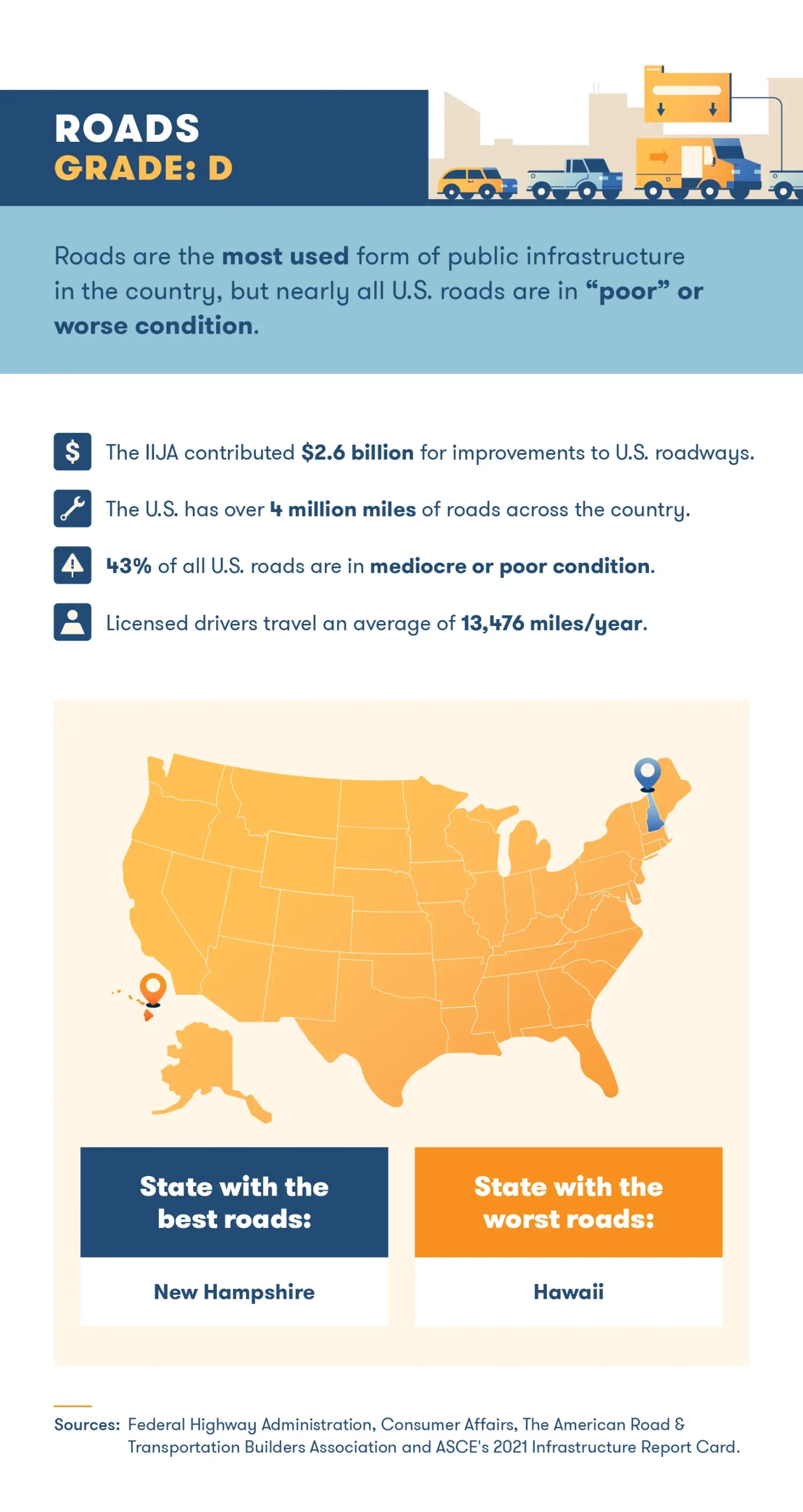
United States Infrastructure FAQ
The state of American infrastructure is constantly changing — especially with the introduction of the Infrastructure Investment and Jobs Act (IIJA). To help you on your way, here is a list of answers to frequently asked questions.
What Type of Infrastructure Does the US Have?
U.S. infrastructure includes rail networks, bridges, energy systems, wastewater services, aviation networks, roadways, drinking water systems and more.
Maintaining and modernizing U.S. infrastructure impacts national security, economic prosperity and the overall well-being of all residents. Infrastructure is the foundation of any country, and important systems will crumble without the proper investment.
How Does US Infrastructure Compare to Other Countries?
The World Economic Forum placed the United States’ infrastructure in 13th place compared to other countries. This ranking is largely attributed to deficiencies in transportation infrastructure when compared to Europe and Asia.
In addition to transportation improvements, the U.S. invests less in renewable energy than other countries. And while the U.S. offers advanced telecommunication networks, many rural areas lack access to high-speed internet compared to other developed nations. Overall, the U.S. infrastructure is functional but there is room for improvement.
How Can We Improve America’s Infrastructure?
Politicians and government officials across the political spectrum have generally agreed that America’s infrastructure needs fixing. The deterioration of the country’s infrastructure puts it at risk of lagging behind the global market. Improving it should be a priority not just for citizens and community groups but for businesses and corporations as well.
Although the country as a whole needs to improve its infrastructure, local and state governments have been tackling the problem areas where they can. According to U.S. News, Oregon has the best infrastructure in the country due to its commitment to improving the quality of life for its citizens. West Virginia, on the other hand, has the worst infrastructure, thanks to dangerous roads and bridges that have deteriorated over the years.
A dedicated investment in infrastructure is in the public’s best interest. We can all do our part by staying informed on how construction trends in the energy, transportation and utility sectors are affected by recent events. Through this combination, we can provide more jobs, increase safety and improve the overall quality of life of U.S. residents.

Additional Sources:
Association of American Railroads | Amtrak Media Center | AWE 2022 Scorecard Executive Summary | Bipartisan Policy Center | Center for American Progress | CISA Water and Wastewater Systems | City of Flint | Congressional Research Service | Consumer Affairs | Cybersecurity & Infrastructure Security Agency | Federal Aviation Administration | Federal Highway Administration | Infrastructure Report Card1234567 | Pillsbury Winthrop Shaw Pittman LLP | The American Road & Transportation Builders Association | The Association of The World Economic Forum | U.S. Department of Energy | U.S. Department of Transportation | U.S. News | Wisevoter
